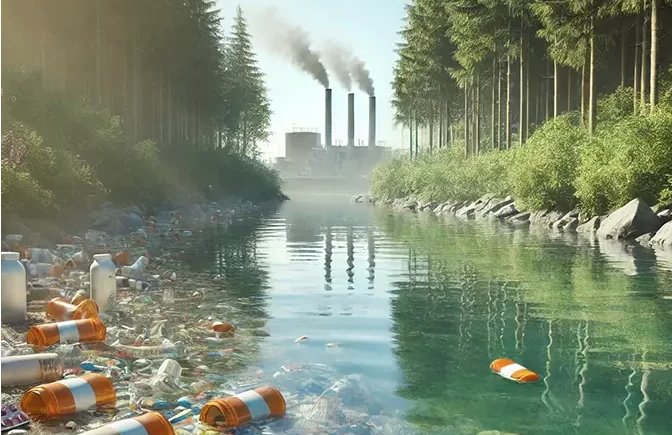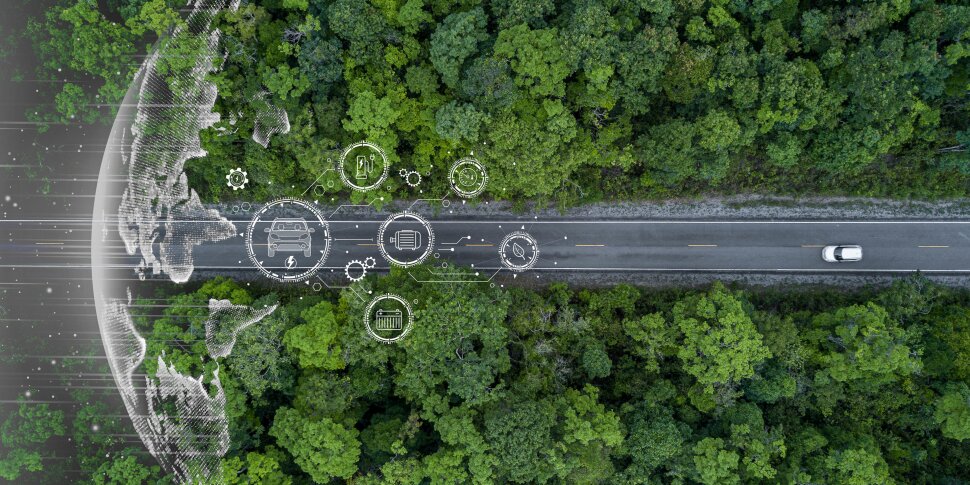Polyethylene Degradation Under Controlled Conditions by Aspergillus sp. Isolated from a Landfill
Downloads
Petroleum-derived plastics such as polyethylene are the most widely used polymers globally. However, once used, they are often not properly segregated or disposed of. Because they resist biodegradation, they cause persistent environmental contamination. This study aimed to analyze the degradation of low-density polyethylene (LDPE) by filamentous fungi isolated from a solid waste landfill. To achieve this goal, we isolated and characterized LDPE-degrading filamentous fungi via phenotypic and genotypic methods. We also determined their degradation potential on the basis of the physical, mechanical, and chemical characteristics of the polymer after 150 days of incubation with the fungi. We isolated a total of 77 fungal strains, 46.75% of which demonstrated LDPE degradation capabilities. The weight loss of the polymer after treatment with the degrading fungi ranged from 4.44% to 20.21%, with a reduction rate of 0.000307 to 0.001504 grams per day and a residual half-life of 450.06 to 2257.65 days. Furthermore, 27.78% of the fungi reduced the tensile strength of the LDPE fragments by 5.61% to 41.72%. Compared with the control, the Aspergillus sp. 40 CIFOS strain presented the most significant physical and chemical changes in the degraded polymer. In conclusion, fungi isolated from solid waste landfills have a high capacity for LDPE degradation. These results, obtained under laboratory conditions, encourage future studies focused on the application of biotechnological processes and the identification of enzymes involved in the degradation process to optimize the bioremediation of contaminated environments.
Downloads
[1] Mészáros, E., Bodor, A., Kovács, K., Papp, S., Kovács, E., Perei, K., Frei, K., & Feigl, G. (2025). Plastic contamination from latex and nitrile disposable gloves has the potential to influence plant productivity and soil health. Journal of Hazardous Materials Advances, 17, 100605. doi:10.1016/j.hazadv.2025.100605.
[2] Ramirez-Silva, N. A., Muñoz-Yustrez, J. L., & Garcia-Gomez, A. G. (2025). Perfil de la contaminación por microplásticos en el agua del Embalse Betania, Departamento del Huila, Colombia. Revista U.D.C.A Actualidad & Divulgación Científica, 28(1), 2593. doi:10.31910/rudca.v28.n1.2025.2593.
[3] Wang, Y. L., Lin, Y. C., Liu, W. C., Lee, Y. H., & Chiu, H. W. (2025). Air pollution and its impacts on health: Focus on microplastics and nanoplastics. Ecotoxicology and Environmental Safety, 299, 118402. doi:10.1016/j.ecoenv.2025.118402.
[4] Williams, A. T., & Rangel-Buitrago, N. (2022). The past, present, and future of plastic pollution. Marine Pollution Bulletin, 176, 113429. doi:10.1016/j.marpolbul.2022.113429.
[5] Kutralam-Muniasamy, G., Pérez-Guevara, F., Elizalde-Martínez, I., & Shruti, V. C. (2020). Review of current trends, advances and analytical challenges for microplastics contamination in Latin America. Environmental Pollution, 267, 115463. doi:10.1016/j.envpol.2020.115463.
[6] Febria, F. A., Syafrita, A., Putra, A., Hidayat, H., & Febrion, C. (2024). Degradation of low-density polyethylene by a novel strain of bacteria isolated from the plastisphere of marine ecosystems. Global Journal of Environmental Science and Management, 10(2), 805–820. doi:10.22035/gjesm.2024.02.24.
[7] Soo, X. Y. D., Muiruri, J. K., Wu, W., Yeo, J. C. C., Wang, S., Tomczak, N., Thitsartarn, W., Tan, B. H., Wang, P., Wei, F., Suwardi, A., Xu, J., Loh, X. J., Yan, Q., & Zhu, Q. (2024). Bio‐Polyethylene and Polyethylene Biocomposites: An Alternative toward a Sustainable Future. Macromolecular Rapid Communications, 45(14), 202400064. doi:10.1002/marc.202400064.
[8] Qiu, X., Qi, Z., Ouyang, Z., Liu, P., & Guo, X. (2022). Interactions between microplastics and microorganisms in the environment: Modes of action and influencing factors. Gondwana Research, 108, 102–119. doi:10.1016/j.gr.2021.07.029.
[9] Raha, U. K., Kumar, B. R., & Sarkar, S. K. (2021). Policy Framework for Mitigating Land-based Marine Plastic Pollution in the Gangetic Delta Region of Bay of Bengal- A review. Journal of Cleaner Production, 278, 123409. doi:10.1016/j.jclepro.2020.123409.
[10] Yuan, Z., Nag, R., & Cummins, E. (2022). Human health concerns regarding microplastics in the aquatic environment - From marine to food systems. Science of the Total Environment, 823, 153730. doi:10.1016/j.scitotenv.2022.153730.
[11] Ajithkumar, V., Philomina, A., Meena, K., Pothiaraj, G., Dey, D., Souravnath, Sowbaranika, M., Chia, S. R., Ashokkumar, B., Chew, K. W., Moorthy, I. M. G., & Varalakshmi, P. (2025). Insights of recent developments in microplastics pollution and its degradation in wastewater and other environment. Journal of the Taiwan Institute of Chemical Engineers, 166, 105504. doi:10.1016/j.jtice.2024.105504.
[12] Yusuf, A., Sodiq, A., Giwa, A., Eke, J., Pikuda, O., Eniola, J. O., Ajiwokewu, B., Sambudi, N. S., & Bilad, M. R. (2022). Updated review on microplastics in water, their occurrence, detection, measurement, environmental pollution, and the need for regulatory standards. Environmental Pollution, 292, 118421. doi:10.1016/j.envpol.2021.118421.
[13] Castañeta, G., Gutiérrez, A. F., Nacaratte, F., & Manzano, Carlos A. (2020). Microplastics: A Contaminant That Grows in All Environmental Areas, its Characteristics and Possible Risks to Public Health from Exposure. Revista Boliviana de Química, 37(3), 4. doi:10.34098/2078-3949.37.3.4.
[14] Rahman, A., Sarkar, A., Yadav, O. P., Achari, G., & Slobodnik, J. (2021). Potential human health risks due to environmental exposure to nano- and microplastics and knowledge gaps: A scoping review. Science of The Total Environment, 757, 143872. doi:10.1016/j.scitotenv.2020.143872.
[15] Ogu, C. J., Makut, M. D., Ekeleme, I. K., & Obiekezie, S. O. (2024). Cassava Peels–A Potential Co-substrate for the Biodegradation of Low-Density Polyethylene (LDPE) using Locally Isolated Bacteria and Fungi. Engineering and Science, 9(2), 26-34.
[16] Khampratueng, P., & Anal, A. K. (2025). Enhancing the biodegradation of low-density polyethylene (LDPE) using novel bacterial consortia: Bacillus sp. AS3 and Sphingobacterium sp. AS8. Journal of Environmental Sciences, 159, 263-270. doi:10.1016/j.jes.2025.04.007.
[17] Cabeza-Vásquez, H., Reaño-Segundo, Y., Sánchez-Purihuamán, M., Barturen-Quispe, A., Caro-Castro, J., Vásquez-Llanos, S., Villanueva-Aguilar, C., & Carreño-Farfán, C. (2025). Low‐Density Polyethylene (LDPE) Degradation by Consortia of Chryseobacterium Sp. and Methylorubrum Spp. Isolated from a Solid Waste Landfill. Applied and Environmental Soil Science, 9895980. doi:10.1155/aess/9895980.
[18] Ahmed, M., Iram, S., Tabassum, N., Sajid, M., Paseutsakoun, K., Aleksza, L., & Székács, A. (2025). Biodegradation Efficacy of Aspergillus niger and Trichoderma harzianum on Low-Density Polyethylene. Polymers, 17(10), 1303. doi:10.3390/polym17101303.
[19] El-Souad, A., & Sayed, M. S. (2025). Biodegradation of Low-density Polyethylene (LDPE) Strips from Waste Plastic Bags Using Marine-derived Fungi. Journal of Applied Biotechnology Reports, 12(1), 1586-1593. doi:10.30491/jabr.2024.455262.1727.
[20] Zhang, W., Li, J., Zhang, Y., Wu, X., Zhou, Z., Huang, Y., Zhao, Y., Mishra, S., Bhatt, P., & Chen, S. (2022). Characterization of a novel glyphosate-degrading bacterial species, Chryseobacterium sp. Y16C, and evaluation of its effects on microbial communities in glyphosate-contaminated soil. Journal of Hazardous Materials, 432, 128689. doi:10.1016/j.jhazmat.2022.128689.
[21] Mishra, S., Swain, S., Sahoo, M., Mishra, S., & Das, A. P. (2022). Microbial Colonization and Degradation of Microplastics in Aquatic Ecosystem: A Review. Geomicrobiology Journal, 39(3–5), 259–269. doi:10.1080/01490451.2021.1983670.
[22] Sathiyabama, M., Boomija, R. V., Sathiyamoorthy, T., Mathivanan, N., & Balaji, R. (2024). Mycodegradation of low-density polyethylene by Cladosporium sphaerospermum, isolated from platisphere. Scientific Reports, 14(1), 8351. doi:10.1038/s41598-024-59032-4.
[23] Yang, W. K., Gong, Z., Wang, B. T., Hu, S., Zhuo, Y., Jin, C. Z., Jin, L., Lee, H. G., & Jin, F. J. (2024). Biodegradation of low-density polyethylene by mixed fungi composed of Alternaria sp. and Trametes sp. isolated from landfill sites. BMC Microbiology, 24(1), 321. doi:10.1186/s12866-024-03477-0.
[24] Ortega, R. I., & Acosta, I. (2021). Degradation of low-density polyethylene by Fusarium solani. Avances en Ciencias e Ingeniería, 12(2), 13-31. (In Spanish).
[25] Munir, E., Pasaribu, Y., Mubtasima, S., & Nasution, A. F. (2024). The Diversity of Fungi in Landfill and their Potential to Degrade Plastic. OnLine Journal of Biological Sciences, 24(3), 374–381. doi:10.3844/ojbsci.2024.374.381.
[26] Sutkar, P. R., Hadkar, S. S., Kamble, S. A., & Dhulap, V. P. (2025). Biodegradation potential of low-density polyethylene (LDPE) using Aspergillus niger and Phanerochaete chrysosporium. Discover Environment, 3(1), 7. doi:10.1007/s44274-025-00188-9.
[27] Gutiérrez Alvarez, A. I., Tirado Rebaza, L. U. M., Maita Vilavila, A. J., Chaparro Montoya, E. E., Rebaza Enriquez, L., Gomez Aguilar, Y. D., Quispe Aro, F. Y., & Limache Quispe, F. D. (2025). Isolation of microorganisms from the Tacna Municipal Landfill for biodegradation of low-density polyethylene. Revista de Ciencia, Tecnología e Innovación, 23(33), 437–448. doi:10.56469/rcti.v23i33.1254. (In Spanish).
[28] Ambur Soncco, R. L., & Mostajo Zavaleta, M. N. (2023). Effectiveness of filamentous fungi in the degradation of low-density polyethylene from the Sicuani landfill, Canchis Province, Cusco. Q’Euña, 13(2), 21-28. doi:10.51343/rq.v13i2.1097. (In Spanish).
[29] Kim, H. R., Lee, Y. E., Lee, E., Suh, D. E., Choi, D., & Lee, S. (2025). Characterization of a low-density polyethylene-oxidizing enzyme in Pseudomonas aeruginosa via transcriptomic and proteomic analysis. Journal of Hazardous Materials Advances, 18, 100726. doi:10.1016/j.hazadv.2025.100726.
[30] KAUR, P., SINGH, K., & SINGH, B. (2022). Microplastics in soil: Impacts and microbial diversity and degradation. Pedosphere, 32(1), 49–60. doi:10.1016/S1002-0160(21)60060-7.
[31] Montazer, Z., Habibi Najafi, M. B., & Levin, D. B. (2019). Microbial degradation of low-density polyethylene and synthesis of polyhydroxyalkanoate polymers. Canadian Journal of Microbiology, 65(3), 224–234. doi:10.1139/cjm-2018-0335.
[32] El-Sayed, M. T., Rabie, G. H., & Hamed, E. A. (2021). Biodegradation of low-density polyethylene (LDPE) using the mixed culture of Aspergillus carbonarius and A. fumigates. Environment, Development and Sustainability, 23(10), 14556–14584. doi:10.1007/s10668-021-01258-7.
[33] Skariyachan, S., Patil, A. A., Shankar, A., Manjunath, M., Bachappanavar, N., & Kiran, S. (2018). Enhanced polymer degradation of polyethylene and polypropylene by novel thermophilic consortia of Brevibacillus sps. and Aneurinibacillus sp. screened from waste management landfills and sewage treatment plants. Polymer Degradation and Stability, 149, 52–68. doi:10.1016/j.polymdegradstab.2018.01.018.
[34] Chigwada, A. D., Ogola, H. J. O., & Tekere, M. (2023). Multivariate analysis of enriched landfill soil consortia provide insight on the community structural perturbation and functioning during low-density polyethylene degradation. Microbiological Research, 274, 127425. doi:10.1016/j.micres.2023.127425.
[35] Ministerio del Ambiente-MINAM. (2021). Final waste disposal infrastructure built by MINAM inaugurated in Ferreñafe and Lambayeque. Ministerio del Ambiente-MINAM, Lima, Peru. Available online: https://www.gob.pe/institucion/minam/noticias/ 506480-inauguran-infraestructuras-para-disposicion-final-de-residuos-construidas-por-el-minam-en-ferrenafe-y-lambayeque (accessed on August 2025). (In Spanish).
[36] Roy, R., Mukherjee, G., Das Gupta, A., Tribedi, P., & Sil, A. K. (2021). Isolation of a soil bacterium for remediation of polyurethane and low-density polyethylene: a promising tool towards sustainable cleanup of the environment. 3 Biotech, 11(1), 29. doi:10.1007/s13205-020-02592-9.
[37] Maroof, L., Khan, I., Yoo, H. S., Kim, S., Park, H. T., Ahmad, B., & Azam, S. (2021). Identification and characterization of low density polyethylenedegrading bacteria isolated from soils of waste disposal sites. Environmental Engineering Research, 26(3), 1–9. doi:10.4491/eer.2020.167.
[38] Gupta, K. K., & Devi, D. (2020). Characteristics investigation on biofilm formation and biodegradation activities of Pseudomonas aeruginosa strain ISJ14 colonizing low density polyethylene (LDPE) surface. Heliyon, 6(7), 4398. doi:10.1016/j.heliyon.2020.e04398.
[39] Arispe Vázquez, J. L., Hernández Juárez, A., Castro del Ángel, E., Aguirre Uribe, L. A., Cerna Chávez, E., & Ochoa Fuentes, Y. M. (2023). Fusarium species in maize grains and stems (Zea mays L.) from subsistence and commercial systems. Nova Scientia, 15(30), 1–23. doi:10.21640/ns.v15i30.3166.
[40] Kuswytasari, N. D., Kurniawati, A. R., Aunurohim, A., Alami, N. H., Zulaika, E., Shovitri, M., Kumari, N., & Luqman, A. (2023). Plastic Biodegradation Potential of Soil Mangrove Mold Isolated from Wonorejo, Indonesia. Advancements in Life Sciences, 10(2), 228. doi:10.62940/als.v10i2.1681.
[41] Saira, Abdullah, Maroof, L., Iqbal, M., Farman, S., Lubna, & Faisal, S. (2022). Biodegradation of Low-Density Polyethylene (LDPE) Bags by Fungi Isolated from Waste Disposal Soil. Applied and Environmental Soil Science, 8286344. doi:10.1155/2022/8286344.
[42] Pitt, J. I., & Hocking, A. D. (2009). Fungi and Food Spoilage. Springer, New York, United States. doi:10.1007/978-0-387-92207-2.
[43] K., R. P., Barnett, H. L., & Hunter, B. B. (1972). Illustrated Genera of Imperfect Fungi (4th Ed.). American Phytopathological Society (APS Press), United States. doi:10.2307/3757954.
[44] Buron-Moles, G., Vandenbossche, V., Gorret, N., Santonja-Blasco, L., González-Aranda, T., Cameleyre, X., & Guillouet, S. (2025). Biodegradation of pre-treated low-density polyethylene (LDPE) by Yarrowia lipolytica determined by oxidation and molecular weight reduction. Polymer Degradation and Stability, 236, 111292. doi:10.1016/j.polymdegradstab.2025.111292.
[45] Gonzales Alcos, V. C. (2022). Biodegradation Capacity of Filamentous Fungi Against Polyethylene. Revista de Investigaciones, 9(3), 205–217. doi:10.26788/riepg.v9i3.1625. (In Spanish).
[46] Mohy Eldin, A., Al-Sharnouby, S. F. S., ElGabry, K. I. M., & Ramadan, A. I. (2022). Aspergillus terreus, Penicillium sp. and Bacillus sp. isolated from mangrove soil having laccase and peroxidase role in depolymerization of polyethylene bags. Process Biochemistry, 118, 215–226. doi:10.1016/j.procbio.2022.04.030.
[47] Goudarzi, V., Shahabi-Ghahfarrokhi, I., & Babaei-Ghazvini, A. (2017). Preparation of ecofriendly UV-protective food packaging material by starch/TiO2 bio-nanocomposite: Characterization. International Journal of Biological Macromolecules, 95, 306–313. doi:10.1016/j.ijbiomac.2016.11.065.
[48] Soleimani, Z., Gharavi, S., Soudi, M., & Moosavi-Nejad, Z. (2021). A survey of intact low-density polyethylene film biodegradation by terrestrial Actinobacterial species. International Microbiology, 24(1), 65–73. doi:10.1007/s10123-020-00142-0.
[49] Altschul, S. F., Madden, T. L., Schäffer, A. A., Zhang, J., Zhang, Z., Miller, W., & Lipman, D. J. (1997). Gapped BLAST and PSI-BLAST: A new generation of protein database search programs. Nucleic Acids Research, 25(17), 3389–3402. doi:10.1093/nar/25.17.3389.
[50] Tamura, K., Stecher, G., & Kumar, S. (2021). MEGA11: Molecular Evolutionary Genetics Analysis Version 11. Molecular Biology and Evolution, 38(7), 3022–3027. doi:10.1093/molbev/msab120.
[51] Amaral-Zettler, L. A., Zettler, E. R., & Mincer, T. J. (2020). Ecology of the plastisphere. Nature Reviews Microbiology, 18(3), 139–151. doi:10.1038/s41579-019-0308-0.
[52] Kučić Grgić, D., Miloloža, M., Ocelić Bulatović, V., Ukić, Š., Slouf, M., & Gajdosova, V. (2023). Screening the Efficacy of a Microbial Consortium of Bacteria and Fungi Isolated from Different Environmental Samples for the Degradation of LDPE/TPS Films. Separations, 10(2), 79. doi:10.3390/separations10020079.
[53] Ali, S., Zakarya, S., & Khaled, S. (2022). Screening and Optimisation of the Biodegradation Potential for Low Density Polyethylene (LDPE) Films by Fusarium Equiseti and Brevibacillus Parabrevis. Biosciences Biotechnology Research Asia, 19(1), 215–229. doi:10.13005/bbra/2980.
[54] Gao, R., Liu, R., & Sun, C. (2022). A marine fungus Alternaria alternata FB1 efficiently degrades polyethylene. Journal of Hazardous Materials, 431, 128617. doi:10.1016/j.jhazmat.2022.128617.
[55] Garcia Moreno, D., Morales Fonseca, D. M., & Nausa Galeano, G. A. (2024). Development of a Bioreactor-Based Model for low-density polyethylene (LDPE) Biodegradation by Aspergillus brasiliensis. Universitas Scientiarum, 29(2), 127–144. doi:10.11144/javeriana.sc292.doab.
[56] Saxena, A., Jain, S., & Pareek, A. (2022). Estimation of possible Biodegradation of Polythene by Fungal Isolates Growing on Polythene Debris. Pollution, 8(2), 567–577. doi:10.22059/POLL.2021.331370.1195.
[57] Puliga, F., Zuffi, V., Baldo, D., Cavatorta, D., Zambonelli, A., Francioso, O., & Sanchez-Cortes, S. (2023). C ladosporium cladosporioides (strain Clc/1): a candidate for low-density polyethylene degradation. Chemical and Biological Technologies in Agriculture, 10(1), 50. doi:10.1186/s40538-023-00419-2.
[58] Khan, S., Ali, S. A., & Ali, A. S. (2022). Biodegradation of low-density polyethylene (LDPE) by mesophilic fungus ‘Penicillium citrinum’ isolated from soils of plastic waste dump yard, Bhopal, India. Environmental Technology, 44(15), 2300–2314. doi:10.1080/09593330.2022.2027025.
[59] Aguiar, A., Gama, L., Fornari, M., Neto, A., de Souza, R., Perna, R., Castro, L., Kovacs, S., Simões, M. F., Ferreira, N., Domínguez, Y., de Castro, L., & Ottoni, C. (2024). Bioprospecting of Mangrove Filamentous Fungi for the Biodegradation of Polyethylene Microplastics. Journal of Marine Science and Engineering, 12(9), 1629. doi:10.3390/jmse12091629.
[60] Spina, F., Tummino, M. L., Poli, A., Prigione, V., Ilieva, V., Cocconcelli, P., Puglisi, E., Bracco, P., Zanetti, M., & Varese, G. C. (2021). Low density polyethylene degradation by filamentous fungi. Environmental Pollution, 274(116548). doi:10.1016/j.envpol.2021.116548.
[61] Mostajo-Zavaleta, M. N., & Ambur-Soncco, R. L. (2022). Efectividad de Aspergillus en la degradación de polietileno. South Florida Journal of Environmental and Animal Science, 2(3), 234–253. doi:10.53499/sfjeasv2n3-002. (In Spanish).
[62] Khruengsai, S., Sripahco, T., & Pripdeevech, P. (2021). Low-density polyethylene film biodegradation potential by fungal species from Thailand. Journal of Fungi, 7(8), 594. doi:10.3390/jof7080594.
[63] Nasrabadi, A. E., Ramavandi, B., & Bonyadi, Z. (2023). Recent progress in biodegradation of microplastics by Aspergillus sp. in aquatic environments. Colloids and Interface Science Communications, 57, 100754. doi:10.1016/j.colcom.2023.100754.
[64] Gong, Z., Jin, L., Yu, X., Wang, B., Hu, S., Ruan, H., Sung, Y. J., Lee, H. G., & Jin, F. (2023). Biodegradation of Low Density Polyethylene by the Fungus Cladosporium sp. Recovered from a Landfill Site. Journal of Fungi, 9(6), 605. doi:10.3390/jof9060605.
[65] Canbulat Özdemir, M., Türkeli, Ü. D., Çalışkan, R., & İmamoğlu, İ. (2025). Impact of accelerated UV aging on chemical structure and sorption behavior of low-density polyethylene microplastics. Journal of Environmental Chemical Engineering, 13(3), 116645. doi:10.1016/j.jece.2025.116645.
[66] Flórez Córdoba, M., Correa Álvarez, M., Hidalgo López, S., Granda Ramírez, F., & Osorno Bedoya, L. (2024). Biodegradación de polietileno de baja densidad en suelo con hongos del género Aspergillus sp. Ciencia e Ingeniería Neogranadina, 34(1), 57–66. doi:10.18359/rcin.7139.
[67] Waqas, M., Haris, M., Asim, N., Islam, H. ul, Abdullah, A., Khan, A., Khattak, H., Waqas, M., & Ali, S. (2021). Biodegradable Potential of Bacillus amyloliquefaciens and Bacillus safensis Using Low Density Polyethylene Thermoplastic (LDPE) Substrate. European Journal of Environment and Public Health, 5(2), em0069. doi:10.21601/ejeph/9370.
[68] Ho, B. T., Roberts, T. K., & Lucas, S. (2018). An overview on biodegradation of polystyrene and modified polystyrene: the microbial approach. Critical Reviews in Biotechnology, 38(2), 308–320. doi:10.1080/07388551.2017.1355293.
[69] Perera, P., Deraniyagala, A. S., Mahawaththage, M. P. S., Herath, H., Rajapakse, C. S. K., Wijesinghe, P., & Attanayake, R. N. (2021). Decaying hardwood associated fungi showing signatures of polyethylene degradation. BioResources, 16(4), 7056–7070. doi:10.15376/biores.16.4.7056-7070.
[70] Munir, E., Sipayung, F. C., Priyani, N., & Suryanto, D. (2018). Potential of bacteria isolated from landfill soil in degrading low density polyethylene plastic. IOP Conference Series: Earth and Environmental Science, 126(1), 12144. doi:10.1088/1755-1315/126/1/012144.
[71] Sangale, M. K., Shahnawaz, M., & Ade, A. B. (2019). Potential of fungi isolated from the dumping sites mangrove rhizosphere soil to degrade polythene. Scientific Reports, 9(1), 5390. doi:10.1038/s41598-019-41448-y.
[72] Jayan, N., Skariyachan, S., & Sebastian, D. (2023). The escalated potential of the novel isolate Bacillus cereus NJD1 for effective biodegradation of LDPE films without pre-treatment. Journal of Hazardous Materials, 455. doi:10.1016/j.jhazmat.2023.131623.
[73] Yin, C. F., Xu, Y., & Zhou, N. Y. (2020). Biodegradation of polyethylene mulching films by a co-culture of Acinetobacter sp. strain NyZ450 and Bacillus sp. strain NyZ451 isolated from Tenebrio molitor larvae. International Biodeterioration & Biodegradation, 155, 105089. doi:10.1016/j.ibiod.2020.105089.
[74] Rong, Z., Ding, Z. H., Wu, Y. H., & Xu, X. W. (2024). Degradation of low-density polyethylene by the bacterium Rhodococcus sp. C-2 isolated from seawater. Science of the Total Environment, 907, 167993. doi:10.1016/j.scitotenv.2023.167993.
[75] Mohanan, N., Montazer, Z., Sharma, P. K., & Levin, D. B. (2020). Microbial and Enzymatic Degradation of Synthetic Plastics. Frontiers in Microbiology, 11. doi:10.3389/fmicb.2020.580709.
[76] DSouza, G. C., Sheriff, R. S., Ullanat, V., Shrikrishna, A., Joshi, A. V., Hiremath, L., & Entoori, K. (2021). Fungal biodegradation of low-density polyethylene using consortium of Aspergillus species under controlled conditions. Heliyon, 7(5), e7008. doi:10.1016/j.heliyon.2021.e07008.
- The authors retain all copyrights. It is noticeable that authors will not be forced to sign any copyright transfer agreements.
- This work (including HTML and PDF Files) is licensed under a Creative Commons Attribution 4.0 International License.














